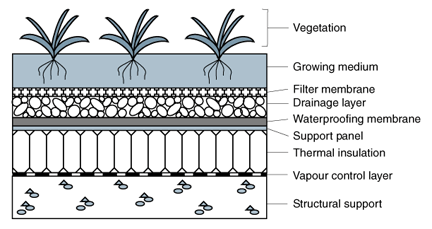Serving all South Florida Since 1996 Call 305-227-1006


D&D
Low - Sloped System
Low slope roofing includes water impermeable, or weatherproof, types of roof membranes installed on slopes less than or equal to 2/12 pitch .
Built-up Roof (BUR) membranes
A built- up roof (BUR) is membrane roofing, made up of asphault or tar - saturated ets, coated felts, fabrics, or matswith alternate layer of asphault or pitch bitumen. Bituen make a BUR waterproof. Fets make it strong and flexible sothe roof can expand and contact. Properly installed and regularly minne, the life expentancy of a BUR is 20 years or more. Besides long life, they are extremely resistant to wind uplift. According to the National Roofing Contractors Association, BUR Membranes have been used in the U.S. roofing industry for more than 100 years. Generally known as “tar and gravel” roofs, BUR membranes have been a time-tested and trusted choice for simple flat-roofing.
BUR Systems have an advantage over other flat roofing systems: they can be hot applied or cold applied. This flexibility relieves some of the limitations of common roof installation, making it easier for roofers to install without compromising time schedules or your company’s business.
Polymer - modified Bitumen Sheet Membranes (MB)
Modified Bitumen (MB) roofing is an asphalt-based, close cousin of the Built-up-Roof (BUR) designed for buildings with low-slope or “flat” roof structures. Engineered modified bitumen roofing membranes originated in Europe in the mid 1960′s and have been used successfully in the United States and Canada since approximately 1975. Modified Bitumen Roofing Systems are designed to withstand harsh exposure to extreme environmental elements. With five layers of protection, it’s one of the most trusted flat roofing systems used in the industry today.
The framework for Modified Bitumen Roofing Systems is a five-layer combination of roofing components.
- Insulation – Used to provide “R” value, or thermal resistance, for temperature stability of the roof system.
- Modified Base Sheets or Plies
- Modified Bitumen Membranes – Factory fabricated sheet membrane composed of co-polymer reinforced with polyester or fiberglass
- Adhesive – Waterproofing material with a bonding agent applied either hot or cold
- Surfacing – Provides UV protection and weathering resistance
Single - Ply Membranes (TPO, PVC,EPDM)
Single-ply membranes are factory-manufactured sheet membranes. They generally are categorized as either thermoplastic or thermoset. Thermoplastic materials can be repeatedly softened when heated and hardened when cooled. Thermoset materials solidify, or "set," irreversibly after heating. Single ply membranes commonly are referred to by their chemical acronyms, such as ethylene propylene diene terpolymer (EPDM).Single-ply membranes can be installed fully adhered or mechanically attached.
Advantages:
- Eco-Friendly
- Saves You Money
Thermoplastic Olefin (TPO)
TPO membranes are produced by calendering with lamination, extrusion with lamination, or extrusion-coating techniques. TPO sheets are a blend of polypropylene and ethylene propylene polymers and usually are reinforced with polyester. TPO sheets contain colorant, flame retardants, UV absorbers and other proprietary substances to achieve desired physical properties.
Polyvinyl Chloride (PVC)
PVC sheets are produced by calendaring, spread coating or extruding, and typically are reinforced with polyester or glass-fiber mats or scrim. PVC sheets contain plasticizers and stabilizers, as well as other additives to impart flexibility and achieve other desired physical properties. Some membranes are available with nonwoven fleece backing adhered to the underside of a sheet.
Ethylene propylene diene terpolymer (EPDM)
The most common thermoset roof membrane is EPDM. EPDM principally is composed of two compounds, ethylene and propylene, that are derived from oil and natural gas.
Garden Roofing System
A roof garden is any garden on the roof of a building. The ultimate choice for eco-friendly “green” roof installations is the Garden Roofing System. Combining the waterproofing power of TPO roofing membrane with the natural beauty of hearty vegetation décor, your roof can have the best of both worlds: green and durable. Garden Roofs not only save energy, they offer a whole host of related advantages for your existing or planned facility. They can be combined with a GAF PlazaDeck system to create not only an energy-saving system, but an outdoor deck, patio, or other functional area- it’s like adding an extra floor to your property at a fraction of the normal cost.
Benefits of Garden Roofs
-Energy Savings
- Tax Incentives
- Land Optimization
- Hassle Free Installation
Garden Roofing Systems can save your company money in energy consumption. The lush greenery absorbs virtually all of the heat, creating natural insulation and superb temperature control. According to one of our main manufacturers, GAF Materials, recent studies have shown an average savings of 15% for companies who benefit from the Garden Roof Systems.










